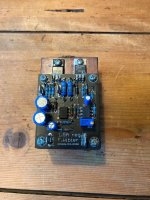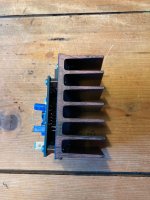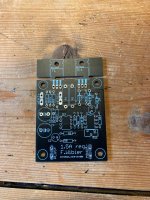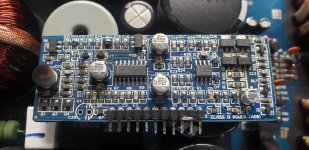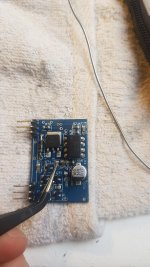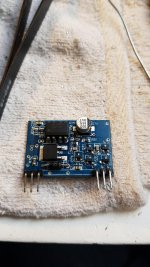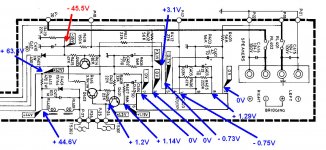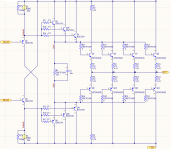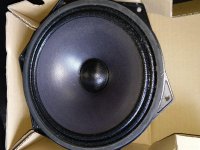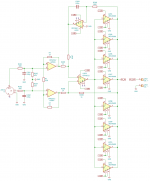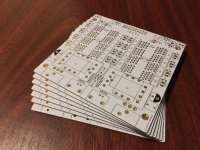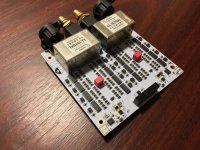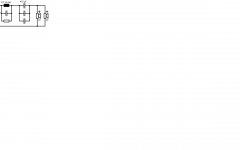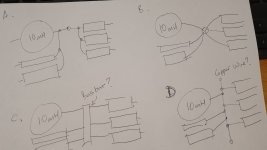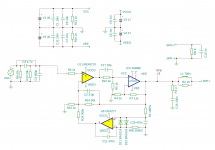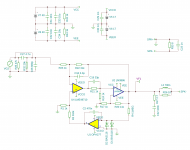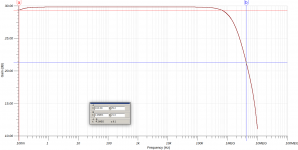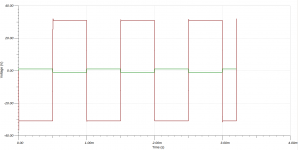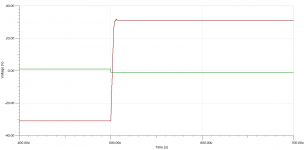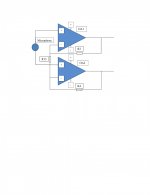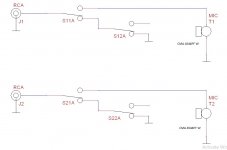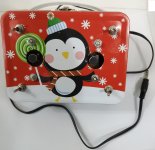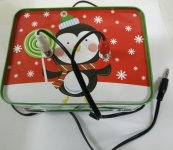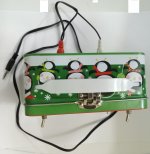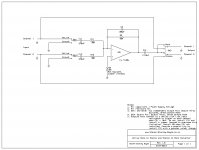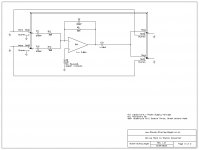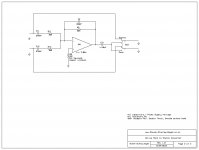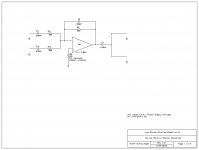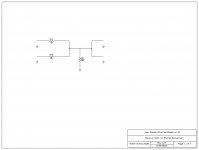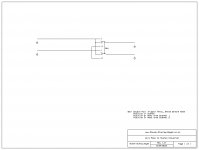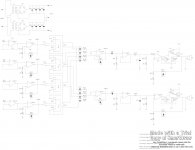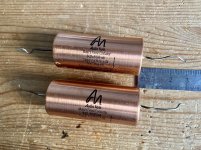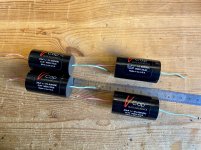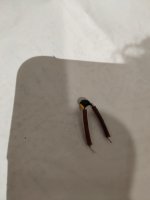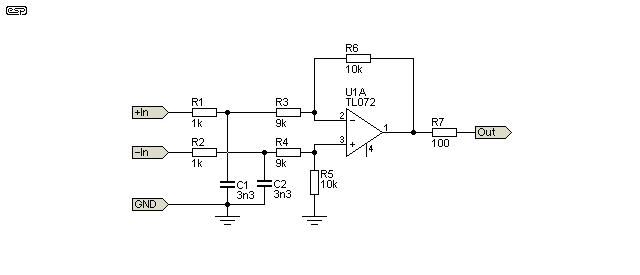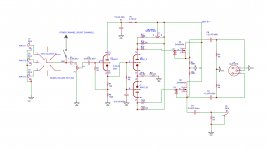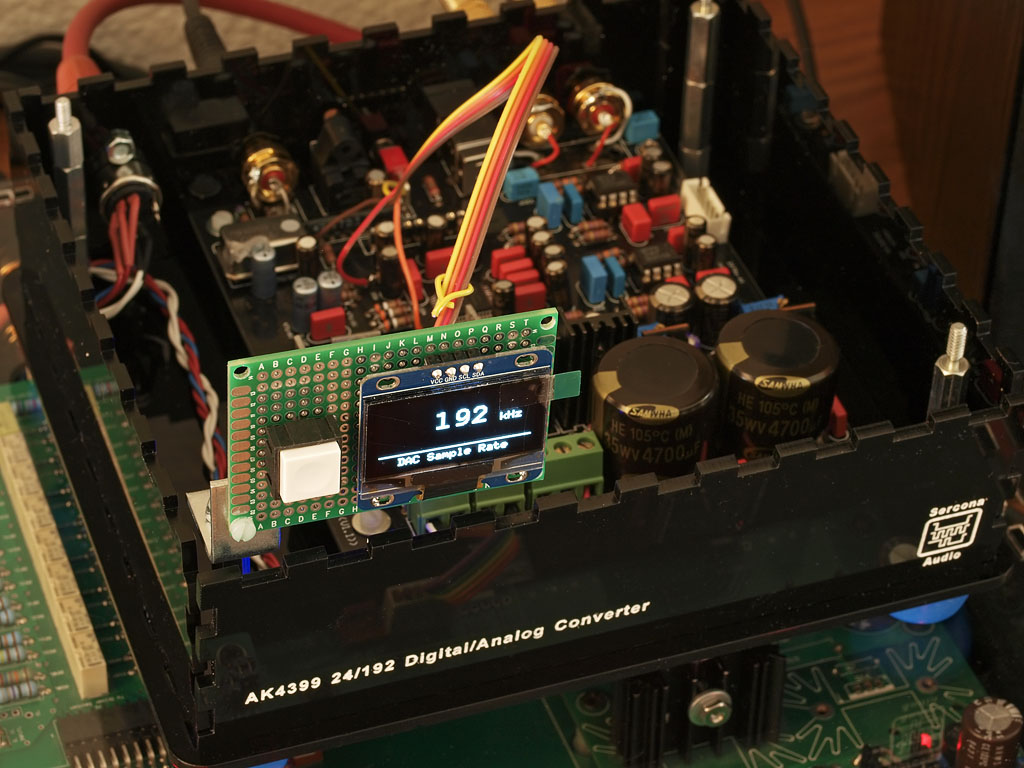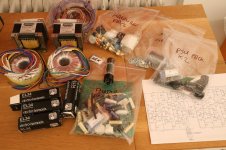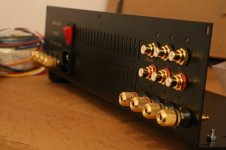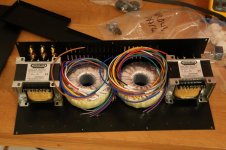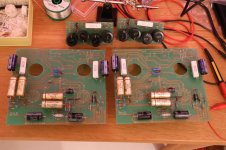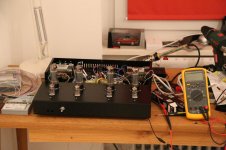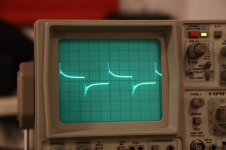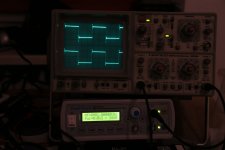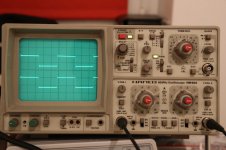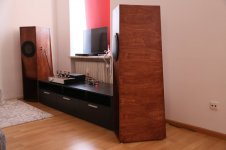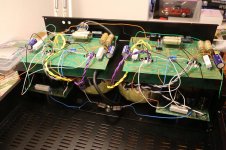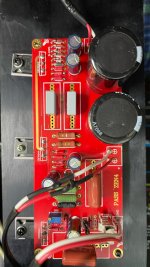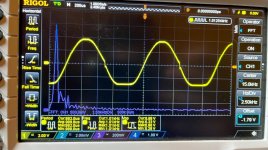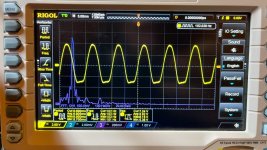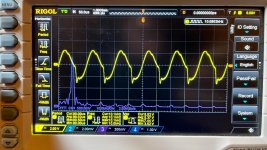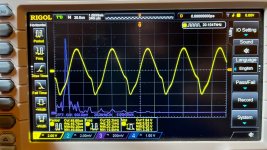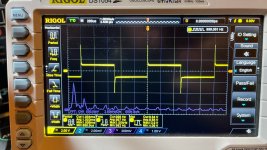I have always been dreaming of designing a circuit which:
1. Amplifies differential signals (signals which cannot be grounded or better not be).
2. Does not have any common point between the signal, the pre amplifier (the circuit) and the amplifier which follows. (I. e. the circuit looks like a microphone without this circuit to the devices connected after and looks like non existing to the microphone.)
Microphone
>+
=
=
===
+
=
=
===
-
=
=
===
-
=
=
===
R2
R4
R13
-
=
=
===
+
=
=
===
+
=
=
===
-
=
=
===
OA1
=
=
===
OA2
=
=
===
Such circuits have been designed long time ago. The most important and useful, yet the simplest is the DIFFERENTIAL AMPLIFIER CIRCUIT built by two working transistors. Such circuits are sold as an IC. Just get one and all problems are solved. Get it if you can, this is. Another schematic which passes through Australia when goes from LA to San Francisco, is the first part of the instrumentation amplifier. This is the first part of the instrumentation amplifier (with the resistors). There are two positively connected operational amplifiers in this circuit: OA1 and OA2. In the standard connection of each of them there should be a resistor from the positive pin to ground. Yes, but we do NOT have a ground, we do not have a middle point. Hence R13. In case R2=R4, the “middle” of R13 is supposed to play ground. So is the “middle” of the microphone. However, these are not connected. Not physically. Anyways, the operational amplifiers would work their ***** off in order to ensure the voltage of the negative pin of each of them is equal to the voltage of the positive pin.
Therefore, the voltage across the resistor R13 will be the same as the microphone voltage. This voltage comes from the output of the operational amplifiers through the voltage dividers: R2 and ½ R13 as well as R4 and ½ R13. In case R2=R4 is selected, and the equal value is said to be R24, then the gain of OA1 is (1+R2/(R13/2)) and the gain of OA2 is (1+R2/(R13/2)). The gain of the whole circuit is the sum of the gain of the two half circuits:
G=Goa1+Goa2
Substitute R2 and R4 with R24=R2=R4, therefore:
G=1+2R24/R13 + 1+2R24/R13 = 2+ 4R24/R13 = 2(1+2R24/R13)
The important consideration is the reduction of the error due to non equal channels would be brought to reduction of the differences of two resistors only. Resistors with very equal values and low aging are easily available and not so expensive.
In case of a different bias of the operational amplifiers, there will be a DC component at the output which can be gotten rid of by the capacitor in the microphone input of the amplifier after the pre amplifier. The requirements on the operational amplifiers are relaxed.
Current path (current return path) check: No current shall be drawn from the microphone. OA1 and OA2 have infinite resistance. Currents will fly from the outputs of the operational amplifiers. OA1 will get a current from one of the rails of the power supply and get it through OA1, R2, R13, R4, output of OA2, through OA2 to the other rail of the power supply. OA2 will get a current from one of the rails of the power supply and get it through OA2, R4, R13, R2, output of OA1, through OA1 to the other rail of the power supply. Thus there will be a full current path.
To check the current path is one of the most important checks in positively connected operational amplifier design due to lack of operational amplifier virtual ground point and infinitely high input resistance. Logically, current cannot pass through an operational amplifier input. Physically is another story.
I haven’t thought very carefully over this schematic but I think this may work. To work or not to work is not very important because I haven’t invented this circuit and I cannot even lie I have. This circuit is the first half of one of the most well known circuits in the world: the so called Instrumentation Amplifier. There are two important variations of the Instrumentation Amplifier: with amplifiers at the front and with buffers at front. Most would use buffers at front to boost the input impedance. Buffers have a straight connection from output to negative input which gives them 100% feedback ratio and thus boosts the input impedance. In other words, whatever is displayed in the output will be present at the negative input and the operational amplifier will work in such a way as to provide such an output voltage to make the voltage difference between the negative and the positive pin 0. This is what the operational amplifier is designed to do. When you connect the output to the negative input, the voltage of the output which is the same as the voltage of the negative input (they are connected) must be equal to the voltage of the positive input. THERE IS NO OTHER WAY TO EQUALISE THE INPUT PIN VOLTAGES. THIS IS THE ONLY WAY THE OPERATIONAL AMPLIFIER CAN GO.
Think of the 100% number this way: In buffer mode, all the operational amplifier does is to repeat the input voltage and nothing else. This is done by the feedback which brings the output to the input as well as by the operational amplifier as a component which is in the straight track of the circuit. In amplifier mode, the operational amplifier does something more than just pushing voltage backwards: the operational amplifier, as a component connected in a circuit, amplifies. We pay with loss of input impedance in order to have amplification and yet high input impedance. When we do not have amplification we get a huge input impedance but there isn’t amplification.
Theoretically, one does not need power to amplify. One needs power only when one drives load. Theoretically, the losses in the operational amplifier are 0. There is power loss at the load only. Also, theoretically, there is no power loss at the source. So, the operational amplifier has been designed to amplify THEORETICALLY without power and only to take power from the power supply and give it to the load when the load so desires (consumes). Amplification is logical, not physical. When the word amplification is used, most often the word is referred to VOLTAGE AMPLIFICATION. These considerations also apply to current amplification BUT, obviously, do NOT apply to power amplification unless we talk power amplification without power consumption which is not very useful but, in theory, even so is possible.
It is important to note: PRACTICALLY the operational amplifier always consumes power for the internal operation of the operational amplifier being only amplification without power consumption at the output. Also, THE MORE THE OPERATIONAL AMPLIFIER CONSUMES THE BETTER AND THE FASTER THE WORK OF THE OPERATIONAL AMPLIFIER! Hence, for most applications, the more the better is OK. Better consume more power but have a better performance. In battery powered application, tough!
Microphone
>+
=
=
===
+
=
=
===
-
=
=
===
-
=
=
===
R2
R4
R13
-
=
=
===
+
=
=
===
+
=
=
===
-
=
=
===
OA1
=
=
===
OA2
=
=
===
Ui1
Ui2
Uai1
Uai2
I
Uo1
Uo2
Ui
Uo
The schematic is rather misleading, although very simple. The misleading comes from the crossing paths of the two operational amplifier circuitries. The easiest mathematical (with a slight combination with physical) analysis is when it is assumed all voltages are positive to some imaginary ground which is far more negative than the most negative possible voltage, i. e. more negative than the negative power supply rail. This is physically OK because we can call any point a reference (a ground) point from – infinity to + infinity and perform our analysis and this analysis must work for all points. However, in case the analysis works for one, the analysis will work for all because the voltages and currents do nothing else but may change signs ACCORDINGLY with any change of reference. The word ACCORDINGLY is very important here. This means whatever changes, something else will change too to maintain the balance. Balance must be maintained not only because we have arbitrarily chosen a point but also because of the Kirchhoff’s laws: all voltages as well as all currents get neutralised. Move the point as you wish. All voltages as well as all currents will continue to neutralise. The same applies in regards to the values of the voltages and currents.
In the schematic, except from the assumption all voltages are more positive than the reference point (imaginary ground), values have been assumed as Ui1>Ui2, therefore Ua1>Ua2 and Uo1>Uo2. Also, remember the only and most important point of the analysis (another than Kirchhoff’s and Ohm’s laws bit of physics (electronics) in the mathematics): When an operational amplifier is connected with a negative feedback THE VOLTAGE OF THE POSITIVE PIN AND THE VOLTAGE OF THE NEGATIVE PIN ARE EQUAL AND THERE IS NO CONNECTION BETWEEN THESE TWO. True for an IDEAL operational amplifier. Ideal operational amplifiers have infinitely high input impedance, infinitely low output impedance, infinitely high internal gain and are infinitely fast.
So, the input voltages are called Ui1 and Ui2 and thus the microphone voltage is:
Ui=Ui1-Ui2
The positive pin voltages are called Ua1 and Ua2 and:
Ua1=Ui1
Ua2=Ui2
The output voltages are called Uo1 and Uo2 and the output voltage of the pre amplifier which will enter the amplifier thereafter is:
Uo=Uo1-Uo2
No current shall fly from the source (microphone) because of the huge input impedances of the operational amplifiers which is almost isolation from the point of view of the source (microphone) when there are negative feedbacks at each of the operational amplifiers.
Since Uo1 has been accepted to be higher than Uo2, a current I shall fly from Uo1 through R2, R13, R4, will meet Uo2 and go to the negative rail of the operational amplifier OA2. No current shall fly to the imaginary ground. Such is not physically connected. Just assumed to be in order to conduct the potential analysis in accordance with the laws of Kirchhoff and Ohm. This current I shall make voltage drops across each and every resistor the current passes through as per the Ohm’s law.
The Kirchhoff’s law says the sum of the voltage drops across the resistors the current passes through must be equal to the voltage across the two points between which the resistors are:
Uo1-Uo2=IR2+IR13+IR4=I(R2+R13+R4)
But
Uo=Uo1-Uo2
Therefore:
Uo=I(R2+R13+R4)
Also:
Ua=Ua1-Ua2=IR13 (this is the voltage between the negative pins of the operational amplifiers OA1 and OA2 which is the same as the voltage across R13 because the two points of R13 are connected to the two negative pins.)
But we have said:
Ua1=Ui1
Ua2=Ui2
And
Ui=Ui1-Ui2
Therefore:
Ua=Ui
But we have said:
Uo=IR2+IR13+IR4
And
Ua=IR13
Therefore:
Uo=IR2+Ua+IR4
But
Ua=Ui
Therefore:
Uo=IR2+Ui+IR4
This is the first relationship between input and output voltage. This is what we have been looking for. Once we have the whole, we will get the gain. There is current I in this relationship. We want to have only input voltage, output voltage and resistors (constants) in order to calculate the gain.
Thankfully, we have said:
Uo=I(R2+R13+R4)
Therefore:
I=Uo/(R2+R13+R4)
Now we have the current expressed as a function of the voltage. Before, we had the relation amongst input voltage Ui, output voltage Uo and current I. When we substitute the current we will get a relation between the input and the output voltages:
Uo=IR2+Ui+IR4
Therefore:
Uo=Ui+I(R2+R4)
Substitute the current and:
Uo=Ui+(R2+R4)Uo/(R2+R13+R4)
And this is the Input Output relation. In order to calculate the gain we need to work out the equation a bit in order to get it in shape: Output equals gain * Input or Uo=GUi. To do so, we need to have a multiplier in front of one of the voltages:
Uo-(R2+R4)Uo/(R2+R13+R4)=Ui
Uo(1-(R2+R4)/(R2+R13+R4))=Ui
Uo((R2+R13+R4-R2-R4)/(R2+R13+R4))=Ui
Uo(R13/(R2+R13+R4))=Ui
Uo=Ui(R2+R13+R4)/R13
Uo=Ui(1+(R2+R4)/R13)
Therefore the gain is:
G=1+(R2+R4)/R13
In case R2=R4= ½ R13, G=2.
In case R2=R4=R13, G3.
In case R2=R4=0, G=1. Physical check: We have two operational amplifiers with outputs connected to their positive pins. O o, buffers. Voltage of the output repeats the voltage of the input! True. The whole schematic is a buffer.
In case R13 is infinity (not equipped), G=1. Physical check. True. The output voltage goes from the outputs to the negative inputs and does not get divided. The availability of the resistor does not make a difference. The input impedance of the unfeedbacked operational amplifier is huge. No current flies. Even in case there was some curren, the current wouldn’t get divided between the resistor and the huge input impedance. (The division will be negligible.)
In practice, the operational amplifier needs some negligible currents in order to operate hence no input must be blocked by huge resistances. Anyways, huge resistance in the feedback is not good because the noise picked up by the huge resistance goes straight into the feedback path and screws up the whole stabilisation of the circuitry. Rule of thumb is 1MΩ which will provide enough current for most of the operational amplifiers and not so much noise. Best don’t go over this value, although there is such a possibility with most of the operational amplifiers.
In this case, the source (microphone) would provide the current needed for the positive pin to work. This is why in other schematics positively connected operational amplifier must not be used without a caution where the current comes from and how much. Negatively connected amplifier may be preferable because the feedback brings current for the negative pin to work and ground provides to the positive. Yes, but then the negative resistor in parallel to the feedback resistor become the input resistance and the input impedance will not be so high. But the working current will be provided by the feedback. The input resistance will be for discharge of the microphone but not for throwing current out of the resistance.
This is illustrated below:
Microphone
+
=
=
===
-
=
=
===
+
=
=
===
-
=
=
===
In case of a positively connected operational amplifier, the necessary current for work of the amplifier is provided by the source (the microphone) and gets returned to the source (the microphone) through the rest of the circuitry. This current CANNOT be compensated for. Will result in signal loss. Hopefully this current is not so high. Operational amplifiers with input built by JFET (Junction Field Effect) transistors have extremely low input currents. Even a microphone is supposed to be able to deliver these.
The resistor, however, does not lead to signal loss, contrary to what I may have said. The microphone generates a current or a voltage (irrelevant) which, in case of current, will circle through the resistor and, in case of perfect amplifier, has nowhere else to go. The voltage has nowhere to go to and cannot be divided. The current may be divided between the low resistor and the huge input resistance of the operational amplifier which means the current will not be divide too.
There is only one problem with the resistor: in case of CURRENT (not voltage, contrary to what I may have said) and a low resistor, the voltage across the resistor will be incredibly tiny. A huge gain may be necessary to amplify. Worse, the noise across the resistor may be stronger than the signal. In this case, the resistor can be taken over and the microphone (in case of perfect amplifier) would work alike with an open circuit: the input impedance of the operational amplifier is huge and is alike isolation (air). So the microphone will provide the highest signal possible. Theoretically, the signal will be infinitely high because the microphone generates current which has nowhere to go and builds up an infinitely high voltage: Ohms law: current through infinitely high resistance equals infinitely high voltage. In practice, the microphone current will go through microphones internal resistance which is in parallel to the microphone. Perfect microphone would have this internal resistance infinitely high. Real ones have lower internal resistance. And this is why a resistor across the microphone will not result in signal loss when the microphone is perfect but with real microphones, this resistor is in parallel to the internal resistor, hence the signal loss.
What I would like to figure out is what happens when I try to force the microphone to operate current inside the microphone (through the internal resistance). I am sure I would get a huge signal BUT I am sure I would get a huge noise too.
The rule of noise is: noise levels are huge across large resistance and tiny across tiny resistances. When the cable is taken into consideration (although shielded) one may as well find to have built an antenna instead.
Microphone
+
=
=
===
-
=
=
===
+
=
=
===
-
=
=
===
A GOOD IDEA WOULD BE TO TRY TO DO THE CIRCUIT WITH INVERTING AMPLIFIERS THIS IS WITH THE NEGATIVELY CONNECTED OPERATIONAL AMPLIFIERS.
Most of the necessary current which must enter the inputs is supplied by the output of the operational amplifier through the feedback resistor.
As a gross generalisation: when possible, always use the inverting amplifier schematics. For microphone pre amplifier where there is a discharge resistor across the capacitor anyways, use the inverting amplifiers schematics and calculate R1||R2 to be equal to whatever the discharge resistor is desired to be.
Pseudo filtering considerations:
Microphone
+
=
=
===
+
=
=
===
-
=
=
===
-
=
=
===
R2
R4
R13
-
=
=
===
+
=
=
===
+
=
=
===
-
=
=
===
OA1
=
=
===
OA2
=
=
===
Rm
C2
C4
In case of a noise problem, a resistor Rm can be put across the microphone. Thus, current will cycle there and not go to the rest of the circuit. This may reduce the sensitivity of the microphone, i. e. result in lower voltage of the microphone. A filter capacitor can be put across the microphone too but the unknown parameters of the microphone will result in impossibility to know the value of the capacitor to adjust the cut off frequency to 25KHz.
C2 and C4 are filtering capacitors which partly “shunt” R2 and R4 at frequencies higher than the cut off frequency which is to be 25KHz in this case. However, this cannot fully filter the frequencies higher than 25KHz because the gain of the whole circuit gives value of 2 when R4 and R2 are shunted. In case we substitute 0’s for R2 and R4 in the formula of the gain, the formula gives a value of 2. Physically, when R2 and R4 are shunted (replaced with a short connection) we achieve two separate buffers similar to the Instrumentation Amplifier with Buffers and the gain is 1.
